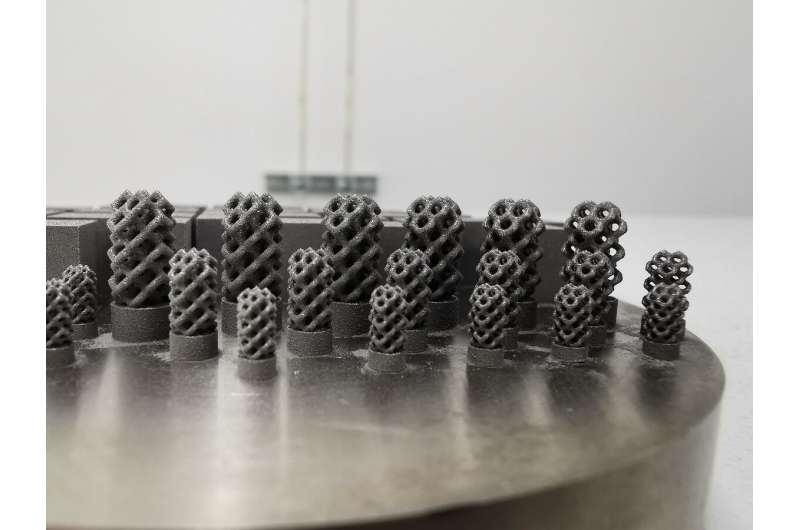Credit: Skolkovo Institute of Science and Technology
Researchers from Skoltech and Sechenov University have 3D-printed and investigated the properties of samples of a porous iron-silicon alloy that the team considers promising for making implants for bone regeneration. The samples exhibited low toxicity, sturdiness, biodegradability, and signs they would accommodate bone growth. The study is published in Biomedical Materials.
To heal bad fractures, implants facilitating tissue regrowth are inserted in place of missing bone. They serve as a matrix in which new bone gradually forms. Ideally, the implants should have dissolved without a trace by the time their job is done. The study reported in this story details tests of an iron-silicon alloy that the researchers deem promising for making such implants.
To function properly, materials for implants should meet a number of criteria. They have to be sturdy, like bone, and porous—so as to provide room for tissue growth. They also need to be biocompatible and biodegradable. That is, the implant should be accepted by the body and naturally decomposed over time, but not too fast, so that the bone would have enough time to grow. Also, the material's degradation should not produce toxic compounds.
"Iron alloys are often used, because the metal is friendly to the body and breaks down at just about the right rate, but it is also too soft if used without any additives. Our materials science team had experience with alloys of iron and silicon before, and we thought we should give them a try in this context, because silicon is also known to be highly biocompatible, nontoxic, readily absorbed and excreted," the study's first author, Junior Research Scientist Julia Bondareva from Skoltech, said.
"We used a 3D printer to produce porous iron-silicon samples from powder. The samples had an arbitrary design convenient for the intended tests of their mechanical and biological properties. We plan to produce anatomically shaped implants for tests in animals," principal investigator Stanislav Evlashin explained.
The team investigated the mechanical properties of the alloy to determine how well the implants would withstand compression and extension, compared to pure iron and the metal's other alloys already used for the purpose. The silicon-iron samples proved superior to those made of pure iron and its other alloys. "We also demonstrated that the implants would decompose as expected over time," Bondareva added.
"We also mapped the elemental composition of the samples," Evlashin said. "The powder we use for printing contains iron and silicon in a certain proportion, and there's always some oxidation going on when printing at high temperature with a laser. So in order to make sure that the mechanical properties are more or less the same at any point in the sample, we had to confirm that the ratio between the two constituent elements—and oxygen, too—was right and they were evenly distributed throughout the sample."
Following the material's synthesis and mechanical tests at Skoltech, the samples arrived at Sechenov University, where further tests with living cells in physiological solution were carried out. Both mouse fibroblasts and human cells derived from the umbilical cord exhibited good adhesion to the scaffold. Microscopy indicated about 70% of the cells remained alive, implying only low toxicity due to iron hydroxide and chloride forming during sample degradation. Importantly, calcium phosphate deposition on the samples was observed—that is, bone tissue actually began to form on the "implant."
While alloys based on other metals—magnesium and zinc—are also under investigation as promising materials for temporary implant manufacture, they likely will not occupy the same niche as their iron-based counterparts. And among the latter, the new iron-silicon alloy seems to offer a winning combination of favorable properties, just right for orthopedic traumatology.
Leading Researcher Anastasia Shpichka of Sechenov University and MSU, who co-authored the study, commented: "Such materials are highly demanded by orthopedic traumatologists. An iron-silicon implant could have mechanical properties comparable to the commercial one; but additionally, it can be degraded in the human organism. This makes possible the gradual replacement of the defect by newly formed tissues. So, some time later, the defect will be restored and no implant will remain in the patient."
More information: J V Bondareva et al, Biodegradable iron-silicon implants produced by additive manufacturing, Biomedical Materials (2022). DOI: 10.1088/1748-605X/ac6124
Provided by Skolkovo Institute of Science and Technology
























